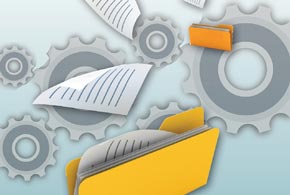More than 12 million passengers a year count on the North County Transit District to speed them through the San Diego region on commuter and light rails and buses. As expert as the NCTD is at moving passengers on rails and roads, it wasn’t always as efficient at the managing information flow within its organization.
A few years back, mountains of paper and disorganized, duplicate electronic files made information processing, storage and retrieval time-consuming and costly. The agency recognized the urgent need for enterprise content management (ECM) software to bring document and records storage up to speed and up to date.
“It was a nightmare,” recalls Sonya Finley, document control coordinator for the NCTD, which is based in Oceanside, Calif. “When I was hired in 2013, there was no formalized records management system. We had tons of paper that had to be archived and then moved to offsite storage, which was costly.
“Electronic documents were stored on a shared drive, with no consistency, no folder structure or naming convention, and folders within folders. Everybody would keep a copy of a document, so we might wind up with 15 or 20 versions in various places.”
The situation posed serious problems for a government agency dealing with contracts, litigation and public records access requests on top of the day-to-day requirements of any organization.
Checking Out Records Management Options
Shortly after Finley signed on, the NCTD sought a records management solution. It held focus groups to determine what its 165 full-time employees needed, then put out requests for proposal. Half a dozen vendors demonstrated their products, and NCTD chose Laserfiche ECM software as the product that best met its current needs, with room for future expansion. It also offered the best value.
Installation was relatively seamless, Finley says, but users needed help adapting to the change. “We did a lot of training, so they had no excuse to fight this,” she stresses. “I met with every department to find out what they were storing, what they needed and how they searched. That led to a folder structure, access rights and universal naming conventions.” The fact that the CEO was “completely on board” also spurred adoption, she adds.
In less than a year, the system was fully configured and fine-tuned, despite a few hiccups along the way. While Laserfiche integrated well with most of the Microsoft Office suite, there were issues with Excel and with the BlackBerry smartphones some executives used. “Like any product, it has minor quirks, but Laserfiche worked with us to provide patches and workarounds,” Finley reports.
North County Transit District now uses the system across every department, including accounting and finance, HR, legal, operations, IT, marketing, records management and administrative services. The ECM system has enabled the agency to centralize records, define consistent processes and procedures, and promote easier resource sharing.
Using Version Control to Reduce Duplication
The elimination of duplicate files is a major benefit. “Laserfiche provides a way for employees to save drafts and collaborate by emailing a link,” Finley explains. “A colleague can work on that document and send a link back. There’s still just one copy of the document. Now, if someone sends a document as an email attachment, the recipients want to know why it’s not in Laserfiche.”
Easy searching is another plus. “Thanks to the metadata the system collects, there are at least 10 to 15 ways to search for a file,” she adds.
The forms module, which allows electronic signatures, has eliminated the need to shuffle paper—a big timesaver. “Bills no longer sit on desks waiting to be approved,” Finley says. Laserfiche has automated the review and approval process for many documents, including staff reports, policies and correspondence.
In addition, onboarding new employees is vastly improved. New-hire information is immediately distributed to every department that needs to know, so the Facilities department can provide building access, IT can set up a phone and laptop, and so on. “Everything is set up days before new employees arrive,” Finley says.
Automation of the Code Enforcement Officers Daily Reports Submittal and Review process has been another big win. The reports must be maintained for use in regulatory audits and legal matters concerning the district. The use of e-forms enabled the officers to create and submit reports online, making them consistent, saving time, increasing efficiency and accuracy, and decreasing off-site storage fees.
Overall, there’s far less paper. “When I got here, we had more than 2,000 boxes in the warehouse,” Finley recalls. “We knocked that down to about 1,000. We scanned records we need to keep forever into Laserfiche, but didn’t scan those about to expire. Plus, we’re generating much less paper now, so our offsite storage costs are greatly reduced.”
By using the ECM system, the North County Transit District has been able to centralize document storage, while improving records management processes and procedures. “We just keep using more and more of the system,” Finley reports. “Looking ahead, we’re already anticipating other ways we can use it.”










